

































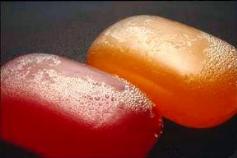 During hard times sooner or later everyone runs out of soap.
During hard times sooner or later everyone runs out of soap.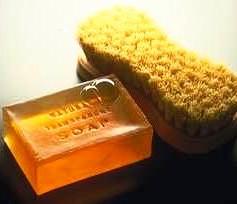
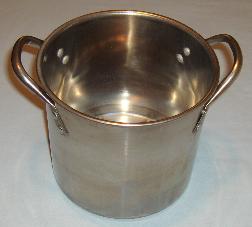 |
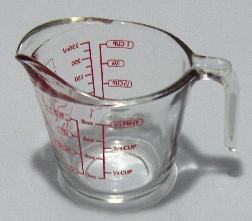 |
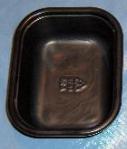 |
 |
| Stainless Steel Pot | Glass Measuring Cup | Food Tray Mold | Thermometer |
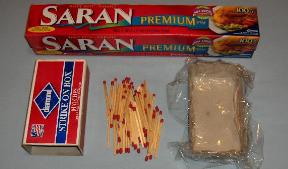 Some type of mold to pour the soap mixture into so it can harden into a bar of soap. For example, you could make a soap mold out of a large empty kitchen matchbox by lining it with plastic food wrap. Or you could use the small black plastic serving trays that contain frozen dinner meals, such as a single serving lasagna meal. The soap mold container should be at least 1 to 1.5 inches deep.
Some type of mold to pour the soap mixture into so it can harden into a bar of soap. For example, you could make a soap mold out of a large empty kitchen matchbox by lining it with plastic food wrap. Or you could use the small black plastic serving trays that contain frozen dinner meals, such as a single serving lasagna meal. The soap mold container should be at least 1 to 1.5 inches deep.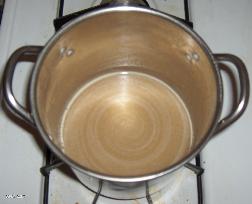 Pour one cup of the melted grease into the big soap making pot. Slowly pour 3/8 cup of the concentrated brown lye water into the soap making pot. Stir the mixture for three-minutes. The mixture will look like brown soup with white streaks in it (see picture on right). Add another cup of grease and another 3/8 cup of concentrated brown lye water and stir thoroughly and continuously for about 15 minutes. The grease and lye must be completely and thoroughly blended together to make soap. If the mixture is not thoroughly blended then the mixture will separate later and you will not get a good soap.
Pour one cup of the melted grease into the big soap making pot. Slowly pour 3/8 cup of the concentrated brown lye water into the soap making pot. Stir the mixture for three-minutes. The mixture will look like brown soup with white streaks in it (see picture on right). Add another cup of grease and another 3/8 cup of concentrated brown lye water and stir thoroughly and continuously for about 15 minutes. The grease and lye must be completely and thoroughly blended together to make soap. If the mixture is not thoroughly blended then the mixture will separate later and you will not get a good soap. When the soap mixture is a solid cream or solid light brown color that displays no streaks when it is first stirred after a ten-minute rest, and it is the consistency of thick gravy or soft pudding (see picture on right), then you can test it using one of the methods in Step Two below. (In the picture on the right the bright white circle is the reflection of my camera flash off the top shinny surface of the stainless steel cook pot.)
When the soap mixture is a solid cream or solid light brown color that displays no streaks when it is first stirred after a ten-minute rest, and it is the consistency of thick gravy or soft pudding (see picture on right), then you can test it using one of the methods in Step Two below. (In the picture on the right the bright white circle is the reflection of my camera flash off the top shinny surface of the stainless steel cook pot.)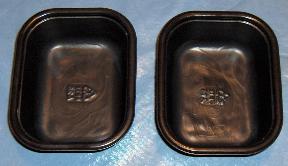 Any container can be used as a soap mold, such as cupcake pans, small boxes, or any other type of container. Lightly grease the inside of the containers. Or place plastic food wrap inside a small cardboard box, such as an empty kitchen matchbox. The small black plastic serving trays that contain a frozen dinner meal, such as a single serving lasagna meal, make really nice soap molds if you wash them out first. The soap molds need to be at least 1 to 1.5 inches deep because the soap mixture needs to retain its heat during the initial phase of this step and if the mold is too shallow it will lose its heat too quickly.
Any container can be used as a soap mold, such as cupcake pans, small boxes, or any other type of container. Lightly grease the inside of the containers. Or place plastic food wrap inside a small cardboard box, such as an empty kitchen matchbox. The small black plastic serving trays that contain a frozen dinner meal, such as a single serving lasagna meal, make really nice soap molds if you wash them out first. The soap molds need to be at least 1 to 1.5 inches deep because the soap mixture needs to retain its heat during the initial phase of this step and if the mold is too shallow it will lose its heat too quickly. Pour the warm soap mixture into the molds and then put the soap molds in a warm location.
Pour the warm soap mixture into the molds and then put the soap molds in a warm location. Turn the soap mold upside down and the soap should fall out, if the soap mold was lightly greased or if the mold was lined with plastic food wrap. If the soap does not fall out of the mold, and you are using flexible plastic molds, then flex the sides and bottom of the mold to loosen the soap from the mold so it can release and fall out. If necessary, you can use a thin bladed knife to separate the soap from the sides of the mold and then gently help the soap out of the mold. (Note: If you used plastic food wrap to line the inside of your soap mold then you will not encounter this problem.)
Turn the soap mold upside down and the soap should fall out, if the soap mold was lightly greased or if the mold was lined with plastic food wrap. If the soap does not fall out of the mold, and you are using flexible plastic molds, then flex the sides and bottom of the mold to loosen the soap from the mold so it can release and fall out. If necessary, you can use a thin bladed knife to separate the soap from the sides of the mold and then gently help the soap out of the mold. (Note: If you used plastic food wrap to line the inside of your soap mold then you will not encounter this problem.)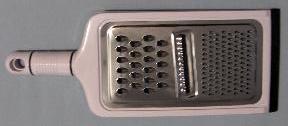 Soap Flakes:
Soap Flakes: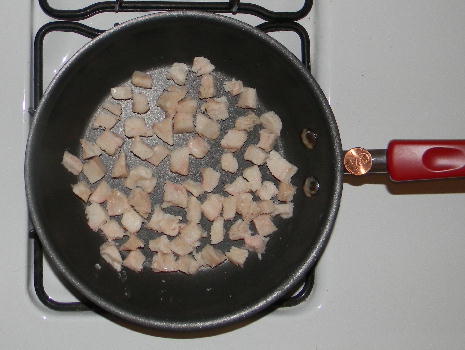 |
 |
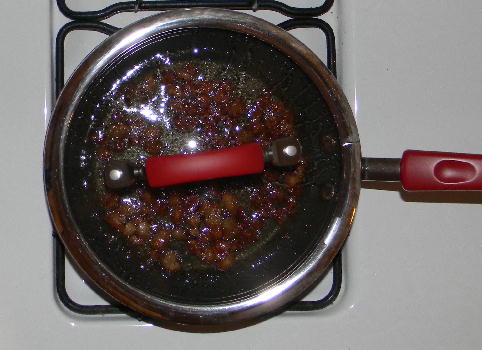 |
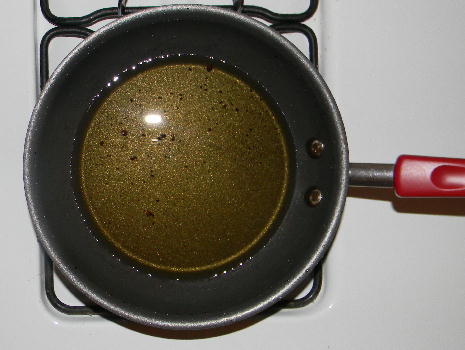 |
| Raw Fat Cut into Small Pieces (See Copper Penny on Red Handle) |
Partially Melted Fat after One-Hour over Low Heat |
Glass Lid on Skillet to Prevent Splattering |
Melted Fat After Removing the Tiny Pieces of Unmelted Fat |
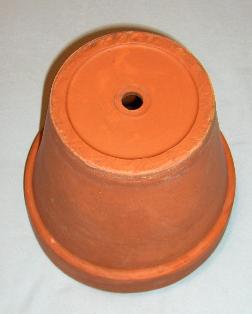 |
 |
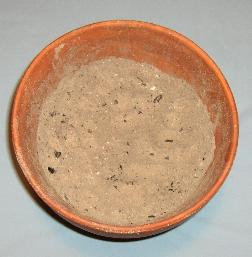 |
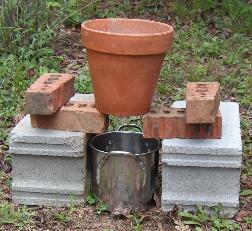 |
| Flower Pot with Hole | Layer of Pine Needles | Ashes Firmly Packed | Final Setup |
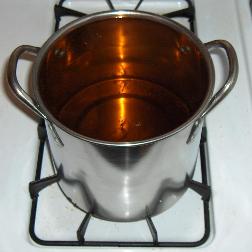 Your objective is to make approximately one-gallon of brown lye water from one fresh batch of cold hardwood fire ashes. Heat about one-half gallon of rainwater to boiling and then slowly pour it over the ashes in the upper container. If the ashes were packed down firmly they should not be swimming or floating in water. While the rainwater gradually disappears into the ashes, heat another one-half gallon of rainwater and then slowly pour it over the ashes. Wait about one-hour and then heat another one-half gallon of rainwater and slowly pour it over the ashes. Wait about one-half hour. If your brown lye water container has about one-gallon of brown lye water then you may stop. If you do not yet have one-gallon of brown lye water, then heat another one-half gallon of rainwater and slowly pour it over the ashes. When you have finished you will have poured a total of approximately 1.5 to 2 gallons of hot rainwater into the pot of ashes. It may take a little while for the water to make its way through the ashes and out the hole in the bottom of the upper container. Be patient. The liquid that drips into the smaller container on the ground will be brown lye water. 1.5 to 2 gallons of hot rainwater will yield approximately one-gallon of brown lye water (see picture on right). (Note: The ashes will absorb and retain between one-half to one gallon of rainwater, depending on the size and shape of your container and how tightly you packed down the ashes in the container. Discard the used ashes after you have extracted one-gallon of brown lye water. If you need more brown lye water, then use a fresh batch of hardwood fire ashes to extract your next gallon of brown lye water.)
Your objective is to make approximately one-gallon of brown lye water from one fresh batch of cold hardwood fire ashes. Heat about one-half gallon of rainwater to boiling and then slowly pour it over the ashes in the upper container. If the ashes were packed down firmly they should not be swimming or floating in water. While the rainwater gradually disappears into the ashes, heat another one-half gallon of rainwater and then slowly pour it over the ashes. Wait about one-hour and then heat another one-half gallon of rainwater and slowly pour it over the ashes. Wait about one-half hour. If your brown lye water container has about one-gallon of brown lye water then you may stop. If you do not yet have one-gallon of brown lye water, then heat another one-half gallon of rainwater and slowly pour it over the ashes. When you have finished you will have poured a total of approximately 1.5 to 2 gallons of hot rainwater into the pot of ashes. It may take a little while for the water to make its way through the ashes and out the hole in the bottom of the upper container. Be patient. The liquid that drips into the smaller container on the ground will be brown lye water. 1.5 to 2 gallons of hot rainwater will yield approximately one-gallon of brown lye water (see picture on right). (Note: The ashes will absorb and retain between one-half to one gallon of rainwater, depending on the size and shape of your container and how tightly you packed down the ashes in the container. Discard the used ashes after you have extracted one-gallon of brown lye water. If you need more brown lye water, then use a fresh batch of hardwood fire ashes to extract your next gallon of brown lye water.)
